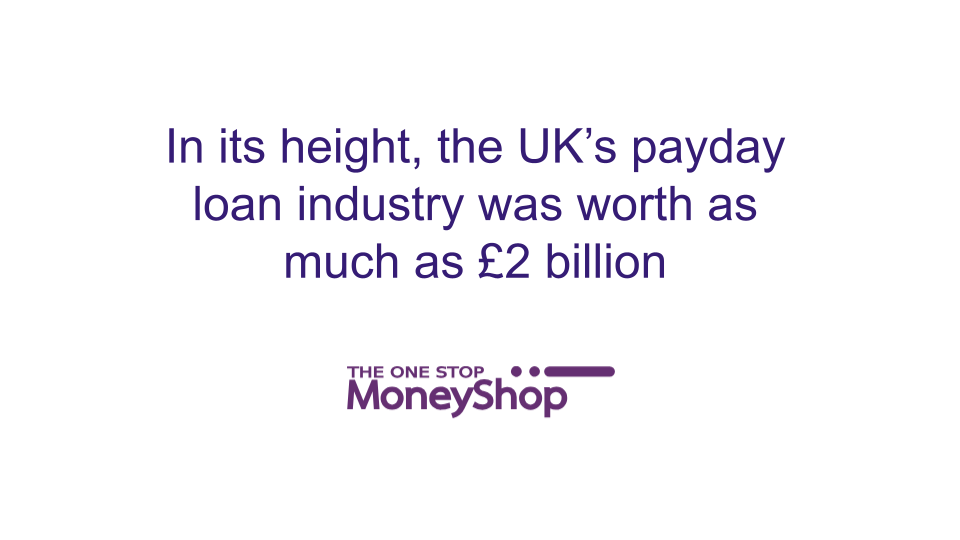What Is the Payday Loans Industry Worth in The UK?
Estimated reading time: 5 minutes
Last updated on November 21st, 2025 at 03:01 pm
Recent estimates suggest the value of the UK payday loans industry is worth between £200 million and £300 million per year, based on high-cost short term lending. This includes traditional payday lenders, high-cost short-term credit providers, and some instalment lenders that serve similar customer needs. The industry may be worth more than this, with recent acquisitions of lenders in the space and increased consumer confidence, and could value the industry as high as £500 million or £600 million.
A decade ago, short-term lenders issued millions of loans annually and operated in a sector worth over £2 billion, driven by payday loan giants Wonga and QuickQuid which owned most of the market share.
However, the introduction of strict FCA rules on affordability checks, daily interest caps and total cost limits dramatically reduced both the number of lenders and the volume of loans issued.
Today, there are estimated to be in the region of 30 regulated direct payday lenders in the market, and short-term lending has shifted toward instalment loans with a minimum of 3 months and lower-risk products.
Demand for quick borrowing is still strong (especially during periods of rising living costs) but the industry’s overall size is tightly controlled by regulation. MoneyHelper also provides guidance on high-cost credit and why the sector looks so different now compared to early 2010s.
Below is a clear look at what the industry is worth today, how it has changed over time, and what the future might look like for payday lenders in the UK.
What Was The Value Of The UK Payday Loans Industry At Its Peak?
A decade ago, the industry was closer to £2 billion, showing just how much the sector has shrunk due to tighter regulation by the FCA, higher barriers to entry, more stringent checks on borrowers and reduced lending volumes. Today, only a small number of FCA-regulated payday lenders remain in the market.

How Has The Payday Loans Market Size Changed Over Time?
The payday loans industry has declined sharply over the last 10–12 years. At its peak, millions of loans were issued every year, with widespread advertising and aggressive marketing.
The turning point came when the FCA took over regulation in 2014 and introduced new rules, including:
- Price cap at 0.8% per day
- Affordability checks compulsory
- Limits on default fees to a maximum of £15
- A total cost cap of 100% so customers are not charged double their loan amount
These measures made lending safer for consumers, but also forced many lenders to leave the market. As a result, the volume of payday loans issued each year has dropped significantly, and the overall value of the industry has fallen in line with that.
What Factors Influence The Size Of The Payday Loans Industry?
The size of the payday loans market depends on the economy, regulation, consumer demand and payday loan alternatives available. When the cost of living rises, some people rely more on short-term credit, which can push lending volumes up. But strict regulation limits how much lenders can charge and who they can approve, which keeps the market smaller than it once was.
Other factors include:
- Changes in household income
- Consumer confidence
- Availability of alternatives (credit unions, overdrafts, BNPL, instalment loans)
- Lender operating costs
- Market exits from high-cost lenders
The result is a tightly controlled industry with limited room for aggressive growth.
How Does The Payday Loans Sector Compare With The Wider Personal Loans Market?
The payday loans market is tiny compared to the wider UK personal loans market. While payday lending now accounts for only a few hundred million pounds annually, the broader personal loans sector was estimated to be worth £42.1 billion last year, likely buoyed by much higher loan amounts of £5,000-£50,000.
Traditional lenders like banks and building societies simply have lower risk profiles, cheaper funding sources, and far more borrowers. They issue larger loans over longer periods, which keeps their overall market share far higher.
What Impact Has Regulation Had On The Size Of The Payday Loans Industry?
Regulation has significantly reduced the size of the payday loans industry by cutting the number of lenders, lowering approval rates, and capping how much firms can charge. When the FCA introduced strict affordability rules and price caps, many lenders could no longer operate profitably, leading to widespread closures. The daily interest cap, total cost cap, and limits on default fees also reduced revenue across the sector.
As a result, far fewer payday loans are issued today, and the industry is now a fraction of the size it was before regulation took effect.
Key regulatory impacts include:
- Lower revenue per loan
- Higher compliance costs
- Stricter affordability rules
- Fewer approved applications
This combination has led to a smaller industry with fewer active firms, fewer loans issued, and significantly lower total lending volumes.
Read here about regulation for the payday loan industry in the UK.
What Are The Future Trends And Forecasts For The Payday Loans Industry In The UK?
The payday loans industry is expected to remain stable but relatively small in the coming years. Borrower demand still exists — especially during periods of economic pressure — but growth is limited by regulation and competition from other short-term finance products.
Future trends may include:
- More instalment-style products replacing traditional “30-day” payday loans
- Increased use of open banking for affordability checks
- Rising consumer interest in credit unions and employer-based lending schemes
- Technological improvements that make applications faster but still compliant
Overall, the industry isn’t likely to return to its pre-2014 size. Instead, it will remain a regulated niche within the wider UK credit market.
The UK payday loans industry is now worth only a fraction of what it once was, largely due to stricter rules designed to protect borrowers. Although demand for short-term credit remains, the industry is smaller, more controlled, and far more regulated than before. Understanding how the market has changed helps borrowers make sense of why payday loan options today look very different from those available a decade ago.




Leave a Reply
Want to join the discussion?Feel free to contribute!